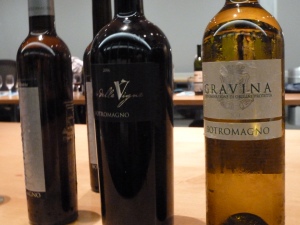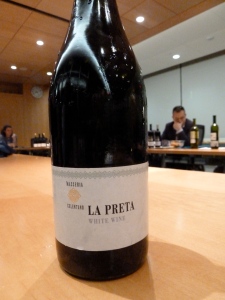Puglia (aka Apulia to the paisans) is basically the southeast heel of the Capezio boot that is italy, running for more than 200 miles along the Adriatic Sea, and mostly known for negroamaro and primitivo, and in the 1970s, crappy vermouth. It’s a region that quite frankly gets overlooked: southern Italy is poorer than the more glamorous north in general–and when you add all the super-powered wine regions up there, it’s hard to blame consumers who never drink past Umbria on the map.
You can find Puglian wines around here, but you have to look (start with Wine Bottega and Vinodivino for starters). The few I’ve had were quite enjoyable, but if you don’t think to look for them you don’t think to ask for them.

Some of the Apulian fabulosity.
Well, a passel of winemakers there are aiming to change that. Every single email I got over the past week seemed to have some event in town for the Puglia posse. These guys were booking it all over town, meeting the industry and the well-heeled likely consumer, culminating at a dual tasting at the WGBH studios for consumers and then for the
Red White Boston Tasting Crew.
What struck me most was that many of the wines, both red and white, had a marked salt water taste. At first, you’d think this would be kind of nasty–I mean, salt water is what you drink when you really really really need to throw up after a night of epic alcohol consumption when you’re 16 and need to leave the slumber party and go home to your parents. (Or so I’ve heard. And don’t try this at home, kids. But I digress.)
But Puglia’s location, on the ocean, in a warm-weather region, means that the grapes have a pretty nice life and conditions to grow and ripen and all that stuff that could lead to decadence and wonderfully luxurious, unctuous fruit flavors. The salinity reins all that potential excess in so that wines end up being crisp and palate-teasing, with a good balance between fruit and acid.
Two of the standout grapes (Italy’s got something like 3,000 native varieties; you’re forgiven for not remembering these, LOL) were new to me:

Caseltrinita's nero di troia
: one of the unusual features about this red grape is that it ripens late in the fall. In Italy, it’s been grown for volume, to be a “filler” grape. The stuff we had tonight tasted a lot more developed for only being a couple of years old–the tannins weren’t causing me to scrape my teeth down with barbed wire like a lot of young Italian reds do. And, again, the salinity was present. To be honest, Italy has a lot of cock-of-the-walk badass reds, so nero di troia might be a hard sell to most people who love their nebbiolo, unless a winery could appeal to the budget-conscious types. These would be a pretty kickass bargain.
Greco: To be specific, greco bianco, imported from Greece nearly 3,000 years ago. No less an authority than Oz Clarke calls Botromagno one of the finer producers of it, even if he isn’t particularly effusive about it, calling its peachy briskness “often rather good in a neutral sort of way.” The 60/40 Greco/white malvasia blend was crisp like a Torrontes from Argentina–but it comes from Gravina, a small DOC–so small in fact, Botromagno is the only grower there.
One of the biggest, most pleasant surprises of the evening was Aglianico: Get it young, and it’s a brat of a wine: tannic and overbearing, especially if you don’t pair it with big overbearing protein-packed food. The two served last night were both pretty well-behaved. Cantine Teanum’s Otre Aglianico was a big hit for me: super brandied cherries and strawberries, rhubarb and pencil shavings (hey, that kid who ate paste in your second grade class was on to something) were held nicely in check by the saline quality of the wine. Botromagno’s Pier delle Vigne was a 60-40 Aglianico-Montepulciano blend; this one had more of a grainy “chaff” taste to it, like barley or hay, and a sulfurish “matchsticky” bite. Interesting in its own way.

One of the WGBH Apulian stanadouts
deserves to be a cult wine someday—another example of excess and restraint. It had a luxurious nose of honeysuckle, floral and pollen, orange blossom, dry melon and mango—and counterbalanced with tobacco (which is often said about reds) and that saline taste. It’s a blend of 70% moscato and 30% sauvignon blanc. I would have preferred maybe 25-28% sauvignon blanc to make it a little less dry, but hell, I’ll take it if I can ever find it again.
Gravisano Malvasia Passita was another big win for Apulia—it was the kind of dessert wine that would make Jerez shake in their soleras in fear, or, as my pal Jason Phelps at Ancient Fire Wine thought, Canadian icewine makers. Sweet without being cloying or diabetes-inducing. Believe me, when we got to take home the leftovers, I yoinked that one forthwith.

More Puglians from the evening
As is typical of Puritan over-regulated Massachusetts, the kicker is that these wines aren’t available here yet, so bookmark this page and check back, or print it out and take it to your local wine outfitter and tell them to tell their distributors to get on the stick. Or find a sympathetic friend in another state
to front for you.
So what about you? Any good experiences–travel, gustatory or otherwise–from Puglia?
Tags: Apulia, Italy, obscure grapes, Puglia, red, Red White Tasting Crew, small batch, white



